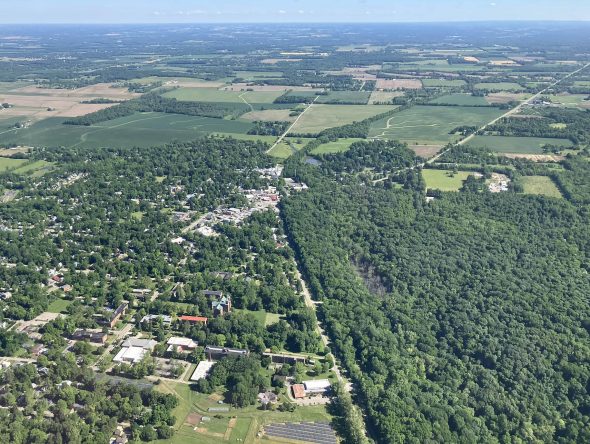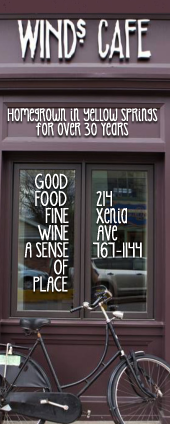
Yellow Springs, as seen from 4,000 feet, in late spring 2024. (Photo by Reilly Dixon)
A Closer Look | The City of Yellow Springs?
- Published: February 6, 2025
“What happens if Yellow Springs ever becomes a city?”
It’s a question that many villagers have asked over the decades as our local population has fluctuated, our small-town economy has become ever more service- and tourism-based and as new housing developments have cropped up.
Now, with scores of additional dwelling units in Yellow Springs either currently under construction or forthcoming, the question has again surfaced in online discussions and in deliberations in Council Chambers.
There’s the new 90-home Spring Meadows subdivision; the proposed 128-unit apartment complex on the site of the old Antioch College Student Union; a potential low-income housing development, of 30–50 units, adjacent to McKinney Middle and Yellow Springs High schools; Home, Inc.’s 32-unit, senior-focused Cascades development; and the occasional new builds filling in existing residential spaces.
Taken together and filled to a hypothetical maximum occupancy, all these new living spaces could grow Yellow Springs’ population — 3,697 villagers recorded in the 2020 U.S. decennial census — to potentially surpass the village’s historically highest population of 4,624 in 1970.
Per Ohio Revised Code, should the upcoming census in 2030 clock Yellow Springs at 5,000 residents, it would officially become the “City of Yellow Springs.”
What then?
According to a number of state and regional experts with whom the News has corresponded over the last several weeks: not much.
As state officials, past Village administrators and some village-turned-city managers elsewhere in Ohio told the News recently, if Yellow Springs were to ever become a city, it would function much the same as it does today — with some notable exceptions.
Responsibility of U.S. 68 in YS
Bevan Schneck, director of public affairs for the Ohio Municipal League, or OML, told the News earlier this month that one of the most material — and perhaps costliest — changes to a village-turned-city is the required maintenance of any roadway maintained by the state or federal government within municipal boundaries.
For Yellow Springs’ part, that would require plowing snow, making repairs and overseeing the continual maintenance of the approximate 1.8 miles of U.S. 68 that runs north and south through Yellow Springs.
Currently, the Village of Yellow Springs is responsible for salting and plowing snow off all arterial and residential roads, while the Ohio Department of Transportation, or ODOT, covers U.S. 68.
Should Yellow Springs become a city, our local public works department would take on the labor and costs of clearing and keeping up with the nearly two miles of the federal highway that runs through town.
“That means buying and storing the added tonnage of salt, putting additional wear and tear on city vehicles, as well as paying for the increased man hours since you’re adding more surface areas to be cleared,” Jason Wright, a consulting inspector for ODOT, said in a recent interview.
Beyond the annual winter work of clearing the roadway, Wright said that the government of a hypothetical “City of Yellow Springs” would also have to cover the costs of milling down and rebuilding or repairing the surface of U.S. 68 — a job that has to happen typically “every 10 or so years,” he said.
“With so many semis and heavy loads going up and down 68, stopping and starting, creating ruts and potholes over time, this maintenance just comes with the territory,” Wright said.
That cost, Wright clarified, would likely be approximately 20% of the total, with the Ohio and federal governments covering the rest. As an example, Wright said that a 2024 repair of a 10-mile stretch on State Route 4 — a $3 million job — cost the City of Germantown approximately $200,000 to fix their three-mile portion.
“It’s not crazy money, but it’s still legit money that the taxpayer is on the hook for,” Wright said, adding that those costs — especially for asphalt — are largely dependent on variable domestic oil prices at any given time.
Changes to government?
When Ohio voters approved a home rule amendment in 1912, they granted state municipalities the ability to frame a charter for local governance. Upon the 1950 passage and later adoption of the Village charter, Yellow Springs has exercised its home rule powers ever since.
According to Schneck, because of that home rule authority, “municipalities largely get to determine how they are governed regardless of size.”
“This is especially the case with charter communities — versus statutory communities that largely follow powers from the state,” Schneck wrote to the News.
That means, should Yellow Springs ever grow into a city, it could maintain its council-manager form of government, as laid out in our charter.
A 1992 memo from the then-Village Solicitor Alan Anderson to then-Council President Tony Bent corroborates this: “Becoming a city does not change the form of government held by the municipality,” the memo reads.
Anderson’s memo — written at the request of Council President Bent, who tasked Anderson with answering the “What if?” question — also points out that, once a village becomes a city, new elections must be held for all elected officials of the local government, namely all existing Council positions, as well as the mayor.
“Even the existing Council members and other elected officials must become new candidates and re-run in the election,” the memo reads.
Though the City of Yellow Springs’ executive functions and other administrative decision-making could remain with the city manager under the continuation of our existing charter, former Village Manager and attorney Laura Curliss suggested that the change to a city may be a good time to reconsider those provisions in the local charter.
“I feel it would be time to revisit the charter and to seriously consider breaking off the executive branch from the legislative branch, i.e. Village Council,” Curliss wrote in a recent email.
Curliss also said that Yellow Springs could benefit from “having an elected mayor who actually runs the city with the help of a professional city administrator that’s similar to the position of the village manager, except answerable to the public.”
“I’ve long been in favor of more democracy, meaning more checks and balances in our government, and a true executive mayor would be one,” she said.
As the News has reported in the past, the position of Mayor of Yellow Springs — currently held by Pam Conine — is largely judicial, not executive, with the mayor presiding over the local mayor’s court.
City employees could unionize
Also per the Ohio Revised Code, once a village becomes a city, a civil service commission must be established — a local agency or actor to regulate the employment and working conditions of city employees.
“I believe this is the most significant change,” Anderson wrote in his 1992 memo to Bent. “Village public employees are not covered by civil service and the Village does not operate under the collective bargaining rules.”
With the existing charter presently making no reference to the civil service commission, Anderson wrote that it would have to be amended to charge a body to oversee hiring, promotions and working conditions within city government, as well as act as the appellate actor for any disciplinary actions, discharges, reductions in pay, suspensions or any discriminatory complaints filed by city employees within the civil service system.
In Curliss’ view, that would mean hiring another staffer to work alongside Judy Kintner, Yellow Springs’ clerk of Council.
In the same vein, the Ohio Revised Code states that city employees could form a union.
As Curliss noted, that would mean the local government would incur the added costs of hiring and employing a labor attorney to represent the city when renegotiating worker contracts every several years.
In her view, the local police department would “definitely” choose to unionize.
Anderson’s 1992 memo also notes that cities are required to create two new public positions: a service director and a director of public safety.
As he explained, a service director would be in charge of streets, transportation, recreation and “probably” cemeteries. A director of public safety would “oversee the fire [department] and police.”
Anderson noted that those two positions could be combined into one position, but did not explain how it would align with the authorities of the existing positions of the public works foreman, police chief or township fire department generally.
Zoning ‘extraterritorial control’
Should Yellow Springs become a city, it would gain a “definite planning advantage,” noted Mark Aultman and Al Denman in a local growth study they penned in the mid-’70s.
Referencing Section 711.09 of the state code, the pair notes that the hypothetical City of Yellow Springs would gain the ability “to plan streets, parks and other open spaces within three miles of its corporate limits and to require any platting to conform to that plan. A village has no such ‘extraterritorial’ zoning power.”
A 1977 “Village Plan Summary” written by a handful of local stakeholders and then-staffers elaborated on that earlier study, outlining that the zoning powers and provisions would remain restricted to Yellow Springs’ corporation limit, but that “extraterritorial control” will allow the city to “exercise more control over the quality of surrounding subdivisions” within the surrounding three miles, “but not the quantity of subdividing or development.”
Options for schools, health
Though the “City of Yellow Springs” would be obligated by the State of Ohio to enact or adopt a number of the above municipal requirements, Anderson points out in his memo that, as a city, Yellow Springs “may” opt to create new departments, commissions and districts.
A City of Yellow Springs Health Department is among them.
“A city can contract with the general health district to provide services for the city or set up its own entire department,” Anderson wrote.
On the matter of creating its own health department in the transition phase, Anderson continued: “If there is an election pending on a question of a levy for health purposes to meet the expenses of the general health district at the time a village makes the transition to a city, the Village should continue to vote on the question of the levy.”
Other special purpose districts that the city could vote to create include conservation districts, water resource management districts, public park districts, public library districts and public transportation districts, among others.
According to Sara Clark, the chief legal counsel for the Ohio School Boards Association, the Yellow Springs Exempted Village School District could change to an exempted city school district — but only by a majority vote of the full membership of the YS Board of Education.
If this transition does occur, Anderson notes, school board members would serve out the remainder of their terms — as opposed to the required reelection of Village Council members.
It remains to be seen whether Yellow Springs will ever reach the critical watermark of 5,000 residents, as determined by the decennial census — the next occurring in 2030.
Until then, Yellow Springs will remain one of the 673 villages in Ohio.
The Yellow Springs News encourages respectful discussion of this article.
You must login to post a comment.
Don't have a login? Register for a free YSNews.com account.

















No comments yet for this article.